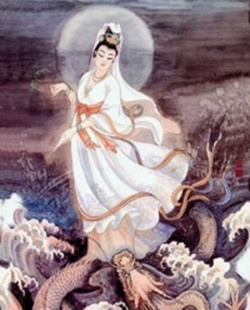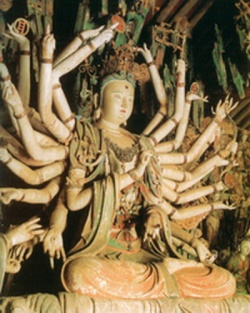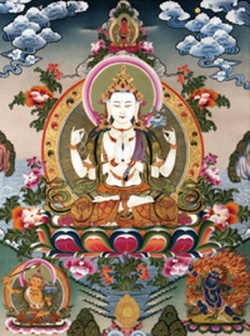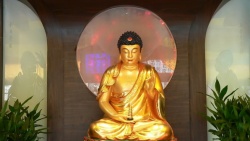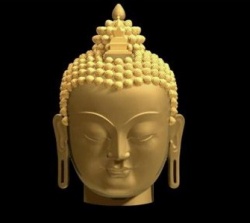Chinese Manifestations of Tibetan Buddhas - Chenreziq
One of the most wonderful dimensions of the Mahayana Tradition of Buddhist practice and teaching are the different manifestations of Buddha’s Qualities of compassion and wisdom. These emanate as different Buddha deities. The form, appearance, costumes, mudras,
implements and jewellery of these Buddha deities differ quite considerably under Chinese & Tibetan Buddhism. Chinese & Tibetans follow the Mahayana tradition and we bring you images of five of the more popular Tibetan Buddha deities in their Chinese manifestation.
Of the many manifestations of Buddhas in Chinese emanations, perhaps the most well known is that of Chenrezig, the Buddha of Compassion, whom Chinese revere as the most beloved Kuan Yin, Goddess of Mercy. Here some of the legends of Kuan Yin, and in another section we introduce also the Chinese equivalents of Tibetan Buddhas Manjushri (Buddha of Wisdom), Ksitigarbha, Samantabhadra and Vajrapani.
KUAN YIN - Goddess of Mercy
kuanyin_ Kuan Yin (觀音) is the universally revered Chinese form of the Buddha of compassion. To followers of Tibetan Buddhism, the compassionate Buddha is known as Chenrezig – who appears as four armed and thousand armed. To the Chinese Chenrezig manifests in female form as Kuan Shih Yin Pusa, Goddess of Mercy.
In Sanskrit, Chenrezig is known as Avalokitesvara, also shown in male form. The name Kuan-shih Yin (觀世音) means "Observing the Sounds of the World".
Folk traditions of ancient China and other East Asian countries have distinctive legends that describe her origin and evolution from Bodhisattva to Buddha.
Avalokitesvara was originally depicted as Buddha when he was a prince, and therefore wears chest-revealing clothing and may even sport a moustache.
Kuan Yin is usually shown as a beautiful goddess in a white flowing robe, wearing necklaces reminiscent of Indian/Chinese royalty. In her right hand she carries a small wu lou containing pure nectar, and in the left, a willow branch. On her crown is the image of Buddha Amitabha who is Kuan Yin’s spiritual guru.
There are many different regional variations of Kuan Yin’s appearance as she is a very popular object of devotion. Through the centuries Kuan Yin appears sitting on dragons, tortoises, with fish, children, and in situations that reflect the many legends that surround her. Kuan Yin is always shown beautiful and smiling, dressed mainly in white and with hand mudras that reflect her immense compassion to answer every prayer and every request made to her.
Chinese art often show Kuan Yin standing or sitting either alone or flanked by children or warriors. The children are Long Nü and Shan Tsai her two disciples and the warriors are said to be Kuan Yu (more familiarly known as the God Kuan Kong) and the classical character Wei Tuo. She is also shown meditating alongside Buddhas and Bodhisatvas, which Buddha or Bodhisattva depending on the Buddhist school presented. In the Pure Land school, for example, Kuan Yin is frequently depicted as standing alongside Amitabha Buddha.
Kuan Yin With The Thousand Arms
The legend of Kuan Yin with a thousand arms speak of her intense compassion. When she saw beings suffering as a result of desire, aversion, blindness, jealousy, and pride she could see their sufferings were immeasurable. She saw it all and a tear dropped from each of her eyes.
When in the presence of Amitabha Buddha, Kuan Yin thought, "As long as there is even one being still suffering, I will strive for the benefit of all. If I break this promise, may my head and body split into a thousand pieces!"
Amitabha is pleased and says, "This promise is excellent. Myself and all the Buddhas of the three times, having taken such commitments, have attained awakening for the benefit of all. I will help you to accomplish that which you have promised."
Kuan Yin’s body then emitted six beams of light that blessed all the beings in each of the six realms of existence: in the human realm, the god realm, deva realm, animal realm, hungry ghosts realm, and hell realm. Kuan Yin worked for many kalpas
[[[eons]]]. Then one day, looking with the eye of knowledge from the top of Mount Meru [the center of the Universe) to see if she has liberated many beings and if the number of beings in samsara [cyclic existence) has diminished, alas, she sees there are still so many suffering beings. In despair she thinks, "I do not have the capability to help all beings; far better that I rest in nirvana". This thought is an immediate contradiction of her promise, so in an instant, Kuan Yin burst into a thousand pieces feeling intense suffering.
Amitabha, by the power of his grace, reconstructs the body of Kuan Yin. He gives her eleven faces and a thousand arms similar to the thousand spokes of the universal king’s Dharma wheel. He gives her a thousand eyes, symbolic of the thousand Buddhas of the present eon.
Kuan Yin with the thousand hands and eyes can henceforth help all beings alongside her other forms with two, four or eighteen arms. Amitabha asks Kuan Yin to carry on with her promise with extra vigor and then transmits the six syllable mantra:
OM MANI PADME HUM
Kuan Yin As The Princess Miao Shan
Another story, describes Kuan Yin as a princess betrothed by her father the king to a wealthy uncaring man. She agrees but only on condition that the king promises to ease three misfortunes. Miao Shan says, "My marriage should alleviate the suffering of those who grow old with age, those who suffer from illness and those who suffer from the having to face death. If my marriage cannot ease any of these misfortunes, I prefer a life of prayers forever".
Miao Shan becomes a nun, but the king arranges hard labour to discourage her. She is forced to work day and night, but her shining compassion make even the animals help her with her work. Frustrated, the king burns down the nunnery. Miao Shan puts out the fire with her bare hands and
suffers no burns. Struck with fear, her father orders her death. At her execution, Miao Shan, realizing the fate the executioner will meet at her father’s hand should he fail to kill her, as well as the negative karma he would accumulate, prevents all this by killing herself, thereby voluntarily taking on the massive karmic guilt the executioner generates for killing her, leaving him guiltless.
This act causes her to descend into the Hell realms. While there, she witnesses first hand the suffering and horrors of hell. Out of compassion, she releases all the good karma she has accumulated through her many lifetimes, using it to free the suffering souls back into Heaven and Earth. In the process, she transforms the Hell realms into a paradise realm. Yama, the Lord of Death, decides to send her back to Earth to prevent the destruction of his realm. On her return, she goes to Fragrant Mountain to meditate.
The Legend of Miao Shan ends with her father falling desperately ill. No physician can cure him. He can only be cured from medicine made from the arm and eye of one without anger. Only Miao Shan of Fragrant Mountain fits the description, so she happily offers her eyes and arms to save her father. The king is cured and goes to Fragrant Mountain to give thanks. When he discovers it is his own daughter who has saved him, he falls to his knees and repents.
Kuan Yin In Other Manifestations
There are many different stories around Kuan Yin. All describe legends associated with the different celestial creatures that are shown with her. There are stories of Kuan Yin and the dragon son, of her saving the dragon tortoise, of how she saves the sailors from storms guiding their ships back to the safety of shores, of Kuan Yin and the tiger, with the pearl... to tell all the stories would fill a book.
Emanation Of The Buddha Of Compassion Avalokitesvara
kuanyin_03The popular worship of Kuan Yin as a Goddess is generally viewed as being directly reflective of Avalokitesvara’s nature. Buddhist canons state that Bodhisattvas can assume whatever gender or form needed to liberate beings from ignorance and suffering.
Avalokitesvara has stated in the Lotus Sutra and the Surangama sutra as having appeared before as a Goddess to save beings from suffering and ignorance. Thus there are Buddhist schools that refer to Kuan Yin as both male and female interchangeably.
In Mahayana Buddhism, the concept of non-duality applies. The Vimalakirti Sutra in the Goddess chapter clearly illustrates an Enlightened Being who is also a female.
In her Bodhisattva Vows, Kuan Yin promises to answer the cries and pleas of all beings. She will liberate all beings from their karmic woes. The Lotus Sutra and Shurangama Sutra describes Kuan Yin as a savior, spiritually and physically. The sutras say that it is
through the saving grace of Avalokitesvara that even those who have no chance of attaining Enlightenment can be Enlightened. Those deep in negative karma can still find salvation through the compassion of Avalokitesvara.
In Pure Land Buddhism, Kuan Yin is the "Bark of Salvation". Alongside Amitabha Buddha, she liberates beings from the Wheel of Cyclic Existence bringing them to Pure Land where they have a chance to accrue the necessary merit to become a Buddha.
Kuan Yin is also revered amongst non-devotional Buddhist schools. Here the mere act, thought and feeling of compassion and love is viewed as Kuan Yin. The contemplative state of being at peace with oneself and others is seen as Kuan Yin.
Avalokitesvara in the HEART SUTRA
In Mahayana Canons, the Heart Sutra is ascribed entirely to the Bodhisattva Kuan Yin. This is unique as almost all the Mahayana Sutras are ascribed to Shakyamuni Buddha. In the Heart Sutra, Kuan Yin/Avalokitesvara describes to the Arhat Shariputra the true nature of reality within the Buddhist teachings. The Heart Sutra is today one of the most widely recited prayers amongst devotees of Kuan Yin.
Kuan Yin In Tibetan Buddhism
Avalokitesvara (known as Chenrezig in Tibetan) is an important deity in Tibetan Buddhism. His Holiness the Dalai Lama is revered as a manifestation of Avalokitesvara and the beloved Goddess White Tara acts as the consort and energizer of Avalokitesvara. According to
popular belief, Tara came into existence from the tear shed by Avalokitesvara. When the tear fell to the ground, it created a lake, a lotus bloomed in the lake revealing Tara. Another version explains that Tara emerged from the heart of Avalokitesvara. In both, it is Avalokitesvara’s outpouring of compassion which manifests Tara as a being.
Avalokitesvara’s six-syllable mantra Om Mani Padme Hum has today become the most popular mantra in the modern Buddhist world recited daily by millions of devotees.
The 33 Chinese Manifestations of Kuan SHIH Yin PUSA
Yang Liu Kuan Yin, who holds a willow branch the symbol of her Healing powers. Her willow branch drips with sweet dew.
Long Tou Kuan Yin with the dragon, symbol of Kuan Yin’s Power
Chi Jing Kuan Yin holding the Prajnaparamita sutra, symbol of her perfection of Wisdom.
Yuan Guang Kuan Yin of wholesome light symbolizing the vast Wholeness of Light that banishes all darkness and shadows.
Yu Xi Kuan Yin the playful Kuan Yin ever happy, laughing, smiling, playful, lighthearted aspect.
Bai Yi Kuan Yin the white-robed Kuan Yin symbolizing her Purity
Lian Wo Kuan Yin sitting on a lotus leaf symbolizing she is enthroned and having dominion over the chakras.
Long Jian Kuan Yin, who views waterfalls or swift water symbolizing she is the Goddess of Energy Flow, and the Waterfall of Light and Blessing coming down from Above.
Shi Yao Kuan Yin, who gives medicines – she is the Bestower of all Healing, Remedies, Cures at all levels.
Yu Lan Kuan Yin, with the fish basket signifying Abundance, Prosperity, Fertility as well as Community, Friendship, Marriage, the Auspicious Symbol of the Double Fishes, also all of this through Mastery of Water and Emotion.
De Wang Kuan Yin, the Queen of Merit or Virtue
Shui Yue Kuan Yin of moon and water - Mastery of emotion, the Water Element; dominion over images and appearances or reflections.
Yi Ye Kuan Yin of the one leaf - attaining the Whole through one part of the Whole, because every part has the whole contained in it
Qing Jing Kuan Yin, blue-throat Kuan Yin for pacifying all poisons--mental, emotional, physical
Wei De Kuan Yin powerful and virtuous Kuan Yin
Yan Ming Kuan Yin, who bestows longevity - extending not only quantity but quality of Life and Life Force.
Zhong Bao Kuan Yin bringing treasures of every kind, including hidden treasures of Teachings and Blessings
Yan Hu Kuan Yin of the rock cave - this is the Secret Chamber, the cave of the subconscious and unconscious, which Kuan Yin has dominion over.
Ning Jing Kuan Yin, calming Kuan Yin bringing harmony, peace of body, mind and soul, helping to overcome anger
A Nou Kuan Yin, shows Kuan Yin seated on a rock looking out over the sea to find beings in distress.
A Mo Di Kuan Yin as an emanation of Buddha Amoghasiddhi, one of the five Dyani Buddhas symbolizing fearlessness
Ye Yi Kuan Yin, leaf-robed Kuan Yin [a healing and nurturing manifestation).
Liu Li Guan Yin lapis lazuli Kuan Yin - lapis is the color of healing and long life, signifying the Healing Buddhas and Bodhisattvas.
Do Lo Kuan Yin emanating as the form of Tara, the swift liberator.
Ge Li Kuan Yin of the clam signifies Kuan Yin power to open or shut all closed and unmoving situations, people and energies, worker of miracles.
Liu Shi Kuan Yin of six hours symbolizing the ancient Chinese “clock” which was divided into 3 periods of six hours. This signifies her mastery of time, so Kuan Yin protects throughout the day and night.
Pu Bei Guan Yin universally compassionate Kuan Yin [[[all-compassionate]]]
Ma Lang Fu Kuan Yin the wife of Ma Lang, based on a legend
He Jang Kuan Yin with palms joined in prayer, symbolizing harmony and goodwill with others.
Yi Ru Kuan Yin of Oneness in all ways signifying wholeness, integration of oneself with Kuan Yin. In this Manifestation she stands on a Cloud and has mastery over all Energy.
Bu Er Guan Yin, the non-dual Kuan Yin not separate or divided or fractured from Oneself or from Kuan Yin.
Chi Lian Kuan Yin, who holds the lotus symbol of mastery of the chakras.
Sa Shui Kuan Yin of pure water signifying pure liquid Light and nectar.
